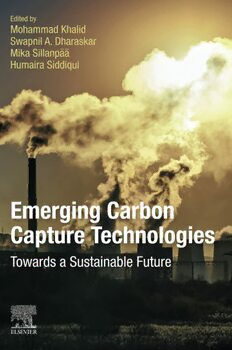Table Of ContentEmerging Carbon Capture Technologies
This page intentionally left blank
Emerging Carbon
Capture Technologies
Towards a Sustainable Future
Edited by
Mohammad Khalid
Graphene and Advanced 2D Materials Research Group, School of
Engineering and Technology, Subang Jaya, Selangor, Malaysia
Swapnil A. Dharaskar
CO Research Group, Department of Chemical Engineering, School of
2
Technology Pandit Deendayal Energy University, Gandhinagar,
Gujarat, India
Mika Sillanpa¨a¨
Department of Chemical Engineering, School of Mining, Metallurgy and
Chemical Engineering, University of Johannesburg, Doornfontein,
South Africa
Humaira Siddiqui
DepartmentofBiologicalSciences,SchoolofMedicineandLifeSciences,
Sunway University, Malaysia
Elsevier
Radarweg29,POBox211,1000AEAmsterdam,Netherlands
TheBoulevard,LangfordLane,Kidlington,OxfordOX51GB,UnitedKingdom
50HampshireStreet,5thFloor,Cambridge,MA02139,UnitedStates
Copyright(cid:1)2022ElsevierInc.Allrightsreserved.
Nopartofthispublicationmaybereproducedortransmittedinanyformorbyanymeans,
electronicormechanical,includingphotocopying,recording,oranyinformationstorage
andretrievalsystem,withoutpermissioninwritingfromthepublisher.Detailsonhowto
seekpermission,furtherinformationaboutthePublisher’spermissionspoliciesandour
arrangementswithorganizationssuchastheCopyrightClearanceCenterandtheCopyright
LicensingAgency,canbefoundatourwebsite:www.elsevier.com/permissions.
Thisbookandtheindividualcontributionscontainedinitareprotectedundercopyrightby
thePublisher(otherthanasmaybenotedherein).
Notices
Knowledgeandbestpracticeinthisfieldareconstantlychanging.Asnewresearchand
experiencebroadenourunderstanding,changesinresearchmethods,professional
practices,ormedicaltreatmentmaybecomenecessary.
Practitionersandresearchersmustalwaysrelyontheirownexperienceandknowledgein
evaluatingandusinganyinformation,methods,compounds,orexperimentsdescribed
herein.Inusingsuchinformationormethodstheyshouldbemindfuloftheirownsafety
andthesafetyofothers,includingpartiesforwhomtheyhaveaprofessionalresponsibility.
Tothefullestextentofthelaw,neitherthePublishernortheauthors,contributors,or
editors,assumeanyliabilityforanyinjuryand/ordamagetopersonsorpropertyasamatter
ofproductsliability,negligenceorotherwise,orfromanyuseoroperationofanymethods,
products,instructions,orideascontainedinthematerialherein.
ISBN:978-0-323-89782-2
ForinformationonallElsevierpublicationsvisitourwebsite
athttps://www.elsevier.com/books-and-journals
Publisher:SusanDennis
EditorialProjectManager:MicaEllaOrtega
ProductionProjectManager:KumarAnbazhagan
CoverDesigner:MilesHitchen
TypesetbyTNQTechnologies
Contents
List of contributors xiii
About the editors xvii
Preface xix
1. Introduction to carbon capture
AnirbanDey,SukantaKumar DashandBishnupadaMandal
1. Carboncycle:sourcetosink 1
2. Sectors responsible foranthropogenic CO emission 4
2
3. EnergyCO -nexus andclimatechange 5
2
4. OverviewofCO capturemethods 7
2
4.1. Precombustion 7
4.2. Postcombustion 9
4.3. Oxyfuelcombustion 9
4.4. CombustiontechnologiescomparisonforCO capture 10
2
5. CO capturefromstationaryindustrialsources 10
2
5.1. Petroleum refining 14
5.2. Cementmanufacturing 15
5.3. Ironandsteel industries 16
5.4. Naturalgasprocessing 16
5.5. Ethanolproduction 17
5.6. Ammoniaprocessing 17
6. TechnologiesforCO separation 18
2
7. Thermodynamics ofCO separation 18
2
7.1. ModelingphaseandchemicalequilibriaofCO
2
absorption 22
7.2. Thermodynamicmodels 23
8. CO captureeconomics 25
2
9. Challenges andfuturedirections 26
10. Conclusions 27
References 28
2. CO capture by absorption
2
BaharehSadeghalvad,HamidEbrahimi,NiyayeshKhorshidi
andAmirrezaAzadmehr
1. Introductiontotheabsorptionprocess 33
v
vi Contents
2. Solventsystemsforchemicalabsorption 34
3. SolubilitycriteriaforCO absorption 35
2
4. PhysicalchemistryofCO absorption 36
2
4.1. Thermodynamicmodels 36
4.2. Chemicalkinetic 36
4.3. Quantumchemistry 37
5. NovelsolventsforCO absorption 37
2
5.1. Amine-basedsolventsystem 37
5.2. Non-amine-basedsolventsystem 39
5.3. Ionicliquids 40
5.4. Deepeutectic solvents 42
5.5. Solventblends 46
5.6. Water-free solvents 46
5.7. Biphasicsolvents 48
5.8. Enzyme-enhancedCO absorption 49
2
5.9. Physicalabsorption solvents 52
6. Absorptioncost andenergyrequirement 52
6.1. Capitalcostestimationbasedonbaremodulecost(CBM) 54
6.2. Energyrequirement 54
7. Recycling andregenerationcriteria 55
8. Challenges andfuture perspective 55
9. Conclusion 56
References 56
3. CO capture by adsorption
2
BaharehSadeghalvad,HamidEbrahimiandAmirrezaAzadmehr
1. Introductiontogas-solidadsorption 63
2. Conventionalsolidadsorbents 65
2.1. Activatedcarbon 66
2.2. Zeolites 66
3. Flexibleadsorbents 67
4. Noveladsorbentmaterials 68
4.1. Metalorganicframework(MOFs) 68
4.2. Carbonnanomaterials 69
4.3. Hybridmaterials 71
4.4. Amine-basedsolidmaterials 72
5. Recent developments inadsorptiontechnology 73
5.1. Utilizingrenewableenergy 73
5.2. Hybridprocessesoracombinationofprocesses 74
6. Adsorptioncostmodelandenergyrequirement 75
7. Challengesandfuture perspective 78
8. Conclusion 79
References 80
4. Chemical looping combustion for inherent CO
2
capture
HariC.Mantripragada
1. GasseparationdthecruxofCO capture 91
2
Contents vii
2. Chemicalloopingcombustion(CLC) 91
2.1. Calciumlooping(CaL)forpostcombustion CO
2
capture 93
3. Fuelsforchemicalloopingcombustion 94
4. Oxygencarriersforchemicalloopingcombustion 96
5. Reactorsystemsforchemicalloopingcombustion 99
5.1. Reactorsforgaseousfuels 100
5.2. Reactorsforsolidfuels 102
6. Performancemodelforchemicalloopingcombustion 105
6.1. Massbalanceequations 105
6.2. Energybalanceequations 109
6.3. Applicationofperformancemodel 109
7. Powerplant applicationsofchemicallooping combustion 112
8. OutlookforCLC 117
9. Conclusions 118
References 118
5. Membrane for CO separation
2
HarriNieminen,ArtoLaariandTuomasKoiranen
1. Introduction 121
2. Membranecontactors 123
2.1. Background andtheory 123
2.2. MembranecontactorsinCO absorption 130
2
2.3. Absorbentsolutions 131
2.4. MembranecontactorsinCO stripping 134
2
2.5. Feasibilityanddemonstrations 135
3. Gasseparation membranes 136
3.1. Background andtheory 136
3.2. Membranematerials 139
3.3. Processdesign,optimization,andcostestimates 148
4. Challengesandfutureprospects 151
5. Conclusions 153
References 153
6. Electrochemical reduction of carbon dioxide to
hydrocarbons: techniques and methods
ReyadShawabkeh,AkramAl-Absi, MohamedShamlooh,
MazenKhaledandIbnelwaleedA.Hussein
1. Introduction 161
2. Reactionmechanism 162
2.1. Firstpathway 162
2.2. Secondpathway 163
3. Techniquesandconcepts inelectrochemistry 163
3.1. Cyclicvoltammetry 163
3.2. Linearsweepvoltammetry 168
3.3. Chronopotentiometry 169
3.4. Chronoamperometry 170
viii Contents
3.5. Faradaicefficiency 173
3.6. Overpotential 173
4. Experimentalinvestigations 174
4.1. Electrodestructure 174
4.2. Gasdiffusionelectrodes 178
4.3. Electrolyte 179
4.4. Temperatureandpressure effects 182
4.5. Rotatingdiskelectrode(RDE) 182
5. Analyticaltechniques for formic acid/formate 183
6. Conclusions 184
References 184
7. Hydrate-based CO separation
2
TinkuSaikiaandAbdullahSultan
1. Introduction 193
2. CO separation technologies 194
2
2.1. Absorption 194
2.2. Adsorptiontechnology 195
2.3. Membranetechnology 196
2.4. Cryogenicseparation 197
3. TechnicaldrawbacksassociatedwithconventionalCO
2
separation technologies 197
4. Gashydrates 198
4.1. Gashydrateformationanddissociation kinetics 199
4.2. Nucleation 200
4.3. Hydrate growth 201
5. GashydrateebasedCO capture 202
2
5.1. CO capturemechanism 202
2
5.2. Operational parametersofhydrate-basedCO separation 204
2
6. CO hydrate-based separationprocess andreactordesigns 206
2
6.1. Continuousprocess 206
6.2. Stirredreactors 207
6.3. Ejector-typeloopreactor(basedonmicrobubble
technology) 208
6.4. Fixed-bedreactor 210
6.5. Unstirredreactor 213
7. Differenthydratepromoters(chemicaladditives) 214
7.1. Tetra-n-butylammoniumbromide 214
7.2. Tetrahydrofuran 217
7.3. Propane 218
7.4. Cyclopentane 219
7.5. Surfactants 220
8. Costcomparisoncalculationforhydrate-based
CO separation 224
2
9. Conclusions 226
Acknowledgment 226
References 226
Contents ix
8. Innovations in cryogenic carbon capture
TusharPatil,SwapnilA.DharaskarandB.RajasekharReddy
1. Introduction 239
2. CO captureapproaches andtechnologies 241
2
3. Cryogenic technologies 242
3.1. Cryogenicdistillation 244
3.2. Cryogenicpackedbed 246
3.3. CryoCellprocess 247
3.4. Antisublimation(AnSU) 248
3.5. Externalcoolingloopcryogenic carboncapture
technology(CCCECL) 249
3.6. Stirlingcoolersystemtechnique 250
4. Benefitsofcryogeniccarboncapturetechniques 251
4.1. Energystorage 251
4.2. HighpurityofCO product 251
2
5. Challengesandlimitationsofcryogeniccarboncapture
techniques 252
5.1. Operating cost 252
5.2. Operationefficiency 252
5.3. Impurities 252
6. Conclusion 253
Acknowledgment 253
References 253
9. CO capture from the atmospheric air using
2
nanomaterials
MohammedAlHinaai
1. Introduction 257
2. Direct atmosphereCO capture 258
2
3. NanomaterialsforDACC 261
3.1. Carbonnanomaterials 261
3.2. Inorganicnanomaterials 267
4. Challengesandfutureperspective 270
5. Conclusions 271
References 272
10. CO transportation: safety regulations and energy
2
requirement
AhmadK.SleitiandWahibA.Al-Ammari
Nomenclature 279
1. Introduction 280
2. CO pipelinesdesignandtechnicalcharacteristics 282
2
3. Pipelinesafetyandintegrity 288
4. Pipelineaccessandtariffregulation 290
5. CO maritimetransportationsystem 291
2
6. Landtransportation 295

